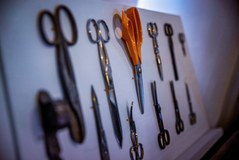Fiskars – the ironworks village that changed its spots
Document Actions
Document Actions
The brick house known as Gamla kvarnen (The old mill) is reflected in the river that runs through Fiskars. The historical pictures in the article were taken by Karl Emil Ståhlberg (1862-1919) and Rafael Roos, 1947, both pictures are part of the collection at the Finnish Heritage Agency.
Fiskars was founded as one of several ironworks in South-Western Finland in 1649. At the time, Finland was still part of Sweden. Moulded and forged products were made in furnaces and with steel hammers. The iron ore came from the Stockholm archipelago.
In the beginning, Fiskars made products for consumers, industry and agriculture, including nails, thread, knives, wheels and more.
The factory had various owners, including Swedish ones, before becoming Finnish-owned. John Julin took over in 1822. During his time, the company started making knives and scissors. Another branch of the company made agricultural tools and ploughs both for its own use and to improve the quality of Finnish agriculture.

In the 1960s, plastic was added as a material alongside steel and copper. In 1967 came the world’s first scissors with plastic handles. The orange colour came about as a coincidence with the help of an independent-minded machinist during prototype development. Later came other scissor models, including some for left-handed people.
Fiskars became a limited company in 1883 and is the oldest company listed on the Helsinki Stock Exchange (since 1915).
The company’s marketing talks about timeless, functional and beautifully designed products, as well as innovation and sustainable growth.
Fiskars Group stands for “design-driven brands for indoor and outdoor living”.
The group’s brands include Moomin by Arabia and Iittala, with many porcelain brands. It also owns Rörstrand in Sweden, Denmark’s pride Royal Copenhagen and companies that manufacture crystal and porcelain in Watford and Wedgwood. Fiskars borrowed 50 million euro from the Nordic Investment Bank in order to fund this.
Fiskars Group has 350 shops across more than 100 countries. Turnover in 2021 was 1.3 billion euro.
Fiskars sees growth potential in the circular economy. Sustainability is seen as a competitive advantage “since sustainable design and new innovation beats the throwaway culture”.
The Fiskars Group companies’ products are linked to the indoors, the outdoors, furnishing and decor. Most of the production has been moved abroad. In the 1980s, production moved from Fiskars to Billnäs ten kilometres away.
Fiskars Group owns large forestry and agriculture areas in the region, but only a few houses in central “Fiskars Village”. This is now an internationally known tourism destination focusing on creative businesses, local craftsmanship, design and various art forms. Fiskars has a large store in the main building where they showcase the width of their range.
The area is marketed as a sustainable tourism destination welcoming 200 000 tourists annually. But it is also home to 600 citizens and 50 companies employing 200 people all year round. One-third of buildings in Fiskars are protected because they are classified as being of cultural and historic value.